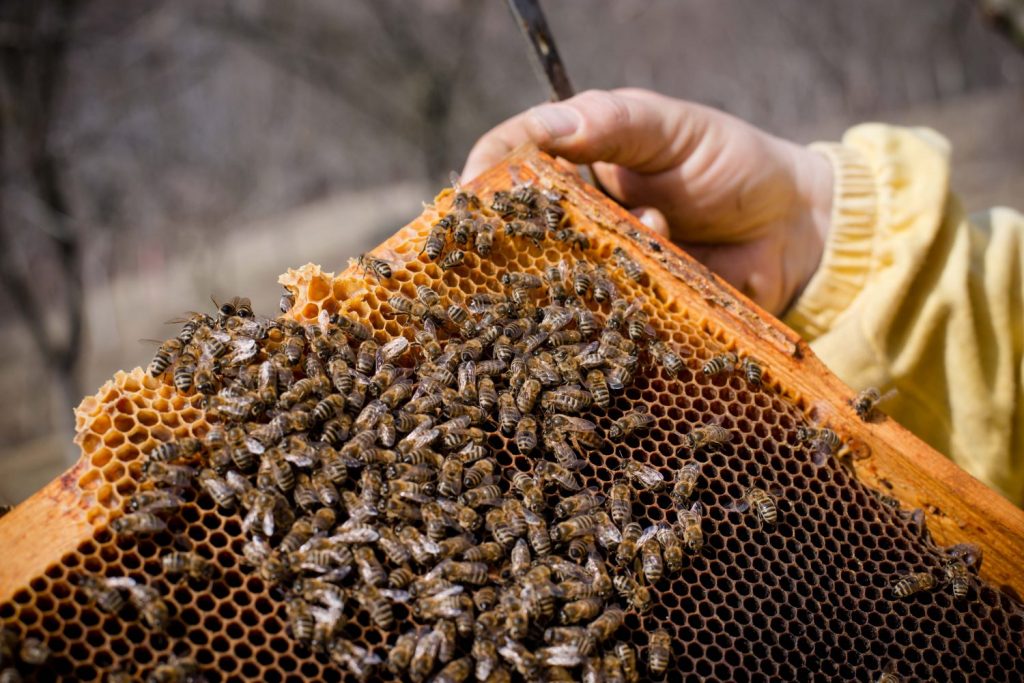If you purchase an independently reviewed item through our site, we earn an affiliate commission. Read our affiliate disclosure.
Quick Overview
Nosema is a serious fungal infection in honey bees caused by two species of microsporidian parasites, Nosema apis, and Nosema ceranae. The disease, known as Nosemosis, can lead to colony collapse due to the inability of forager bees to gather sufficient resources, ultimately resulting in the death of the colony. Symptoms include dysentery, visible as fecal streaks near the hive entrance, and crawling bees unable to fly. Diagnosis is complex, often requiring microscopic examination or molecular techniques like PCR to differentiate between the two Nosema species.
Treatment options include the use of Fumagillin, a naturally derived compound, which inhibits spore growth but does not kill the spores. Alternatives to Fumagillin are being researched, and beekeepers are encouraged to participate in trials. Other commercial products like HoneyBHealthy®, ApiHerb, Vita Feed Gold, and Nozevit are also used, with varying degrees of reported success.
Natural treatments are gaining interest for their potential to control Nosema without the risk of the parasites developing resistance. Thymol, an essential oil, has shown promise in trials, and a recipe for thymolated syrup is provided for beekeepers to use as a treatment. Tea tree oil is another natural option, though care must be taken to avoid toxic concentrations.
Prevention of Nosema is preferable, focusing on maintaining strong, healthy colonies with good ventilation and sufficient winter food stores. Hive hygiene is critical, and after an outbreak, thorough cleaning and possibly fumigation or heat treatment of the hive are necessary to prevent reinfection.
While Fumagillin remains the primary treatment for Nosema apis, its effectiveness against Nosema ceranae is questionable. You should explore a combination of treatments and preventive measures to manage this challenging disease effectively.
About Nosema

Nosema is a fungal parasite of honey bees that causes the disease Nosemosis. There are two species of the microsporidian parasite: one is the Nosema Apis and the other is the Nosema Ceranae. Both are problematic to beekeepers in the USA and globally. The Nosema Ceranae has spread in recent years to many parts of the world. In the USA and Europe, Nosema Apis was the endemic species. However, the Nosema Ceranae has evolved alongside the Asian honey bees and then spread throughout the world. Avoiding losses from Nosema infections is important in beekeeping. This article gives you a better understanding of the disease and how to go about conducting Nosema disease treatment for honey bees.
Effects of Nosema Disease on Honey Bees
Honey bees are affected by Nosema infections in various ways. Ultimately, the colony collapses and even absconding does not help much. Before the honey bee colony absconds or dies out, it undergoes a trying time during which forager bees cannot bring enough resources to keep the colony strong and healthy. Honey bees going out to forage are very much affected by Nosema Ceranae. They often leave the beehive for foraging trips but do not return.
An infected bee takes about 8 days from infection to eventual death. This leaves the colony with a queen bee and many nurse bees but few foragers. Food resources in the beehive such as honey and pollen get depleted over time since bees use them up due to poor foraging by the colony. Eventually, the colony succumbs to the disease when the number of bees in the beehive drops below viability.
Nosemosis Symptoms and Diagnosis
Infection by Nosema is not easy to distinguish from other honey bee diseases. Its most notable symptom is dysentery. Diagnosis is based on the identification of dysentery among other factors, such as the time of year and crawling honey bees. The disease is common in spring after bad weather. It may also infect the honey bee colony in winter and is noticed in spring when beekeepers open their beehives after wintering them. Female worker bees are more affected in the beehive by Nosema than drone bees. The queen bee is not often infected by the fungi, because worker bees that have the disease do not participate in feeding the queen bee.
Identifying Signs of Nosemosis
- Dysentery when honey bees have Nosema is seen as streaks of their poop on the outside of the beehive. The streaks of fecal material are found around the entrance of the hive because the bees void it as soon as they are outside.
- You will also note bees are unable to fly. They crawl around even when outside the beehive in large numbers.
- Other symptoms you can use to distinguish Nosema from other honey bee diseases are:
- An increase in the girth of the honey bees’ abdomens;
- A lack of a sting reflex in worker bees;
- Replacement of the queen bee early on in her lifespan.
Honey bees whose colonies have been infected by Nosema that reached the queen have to replace her. In a Nosema infection of the queen bee, her ovaries degenerate to a point where egg production is severely impacted. She is easily superseded.
Nosemosis Diagnosis
Honey bee colony infection with Nosema Ceranae has substantially more serious effects on the digestive system of bees than Nosema Apis. On the other hand, Nosema Ceranae does not present all the classical symptoms of Nosema infection. Clinical diagnosis of Nosema infection is done using microscopy, dissection, and nucleic acid technologies. The ventriculus of infected bees appears whitish and is swollen in the late stages of nosemosis.
Macerating infected bees in water and then examining the water reveals spores of Nosema. A light microscope cannot be used to reliably differentiate between spores of Nosema Apis from those of Nosema Ceranae. Electron microscopy is the only sure way to tell whether observed Nosema spores are from the Nosema Ceranae or the Nosema Apis. PCR technologies can also be used to test for the presence of Nosema DNA in samples. It helps reliably identify both the Nosema Apis and Nosema Ceranae spores.
Commercial Products to Treat Nosema Infestations
1. Fumagillin for Bees

Fumagillin is a popular fumigant used to treat beehives and honeybee colonies for Nosema. It is the best available treatment for Nosema in honey bees. It is a compound derived from fungi that occurs naturally in the soil and organic matter that is decaying. The compound is sold under various brand names including Fumagillin-B and Fumidil-B. It is mixed with feed or water and given to bees. Ingestion of Fumagillin results in stopping the growth and multiplication of spores in the guts of bees. It is important to note that Fumagillin does not kill the Nosema spores it comes into contact with.
Applying Fumagillin requires strict adherence to the instructions on the label. Over-application can be injurious to both bees and beehive products. Under-application gives results that are below par.
Alternatives to Fumagillin
Further research into alternatives to Fumagillin is needed. Beekeepers can contribute to such research by allowing trials on their honey bee colonies and by donating other resources to the research studies. The results are beneficial to the research teams, beekeepers, and agriculture authorities that share the information with other beekeepers.
2. Honey B Healthy Nosema
HoneyBHealthy® is a solution of emulsified lemongrass and some spearmint oil. The product is sold to beekeepers for control of Nosema and has worked for some. They feed their bees the product in solution. The syrup is the best method of getting bees to consume some of the HoneyBHealthy®. Unfortunately, scientific data to confirm the efficacy of the product when used against Nosema is not readily available.
3. ApiHerb and Vita Feed Gold
Two closely related products used in Western Europe to control Nosema, are ApiHerb and Vita Feed Gold. They are effective and have data to back their claims. Vita Feed Gold is sold as an enhanced liquid feed for use with honey bees. The company that makes the feed also has a product called Vita Feed Green that is great for the control of chalkbrood and fortifying honey bee colonies. It contains various essential oils. ApiHerb is made and sold by the company that also makes Apilife Var for the control of Varroa mites in honey bee colonies.
4. Nozevit
Central Europe has a product called Nozevit that beekeepers use to keep Nosema from infecting their honey bee colonies. It is great for use in wintering bees. The product contains extracts from the bark of trees. These products used in Europe are also suitable for use in the USA, where they are approved by the FDA.
How to Treat Nosema Infestation Naturally
Nosema infections are best dealt with using Fumagillin. It is the most effective treatment for the fungal disease. In addition to Fumagillin, however, various other natural treatments have been tried over time. They have given varying degrees of efficacy against the disease. Using treatments other than Fumagillin for Nosema control ensures that the fungus does not develop resistance to one treatment. It also helps to allay concerns about Fumagillin showing up in beehive products, and some options they can use to keep Nosema under control. Using natural treatments in addition to Fumagillin to control Nosema in honey bees, allows for customization of treatments too.
Plants produce a wide range of compounds in their bark and sap. They present the best place to look for natural treatments. In beekeeping, plants are used in many treatments for various diseases and parasites. They can also be used to deter pests from coming into the beehive. The plants are used in various forms including extracts such as essential oils.
Thymol and resveratrol from the skins of red grapes are very promising treatments. Thymol comes with the added advantage of suppressing fungal growth in honey bee feeders. It is also effective against a range of other parasites and pests of honey bees such as mites. In trials conducted by researchers, thymol keeps beating other natural products in its efficacy in controlling Nosema.
Thymol Syrup Recipe for Nosema Treatment
Use the following recipe to prepare thymolated syrup that you will feed to honey bees for control of Nosema:
- Use either ethyl alcohol or isopropyl alcohol for the base mixture. Alcohol dissolves thymol crystals a lot better than water. After making the alcohol preparation, you can then add water to the required volume for the proper constitution. The alcohol helps with dissolving thymol in water. Do not use denatured alcohol.
- Thymol usually comes in crystals. Use 12.5 grams of the crystals for this thymolated syrup. Mix the 12.5 grams of thymol with 88 ml of alcohol. This should give you about 100 ml of the resulting solution. This gives you what is called a premix solution.
- Add 2 ml of the premix solution to every gallon of thymolated syrup you want to make. This is a rate of 2 teaspoons per 5 gallons of water. Stir the solution thoroughly so that the thymol dissolves well in water. The alcohol used in this recipe helps thymol dissolve better in water. Improper constitution of this syrup can result in the concentration of thymol being more in one-half of the syrup and poisoning honey bees.
Caution with Thymol
Thymol can hurt your skin and eyes. When working with the compound, make sure to wear nitrile gloves. Do not touch your mouth, eyes, ears, or mucous membranes when working with thymol. You should also wash your hands after finishing working with thymol. In the unfortunate event that some thymol comes into contact with your skin or eyes, wash it off with large amounts of warm water. Cold water does not dissolve thymol well and is not very effective at washing off thymol.
Treating Nosema Infections with Tea Tree Oil
Tea tree oil is a natural treatment you can use to control Nosema. It is used alone or alongside other oils, including spearmint and lemongrass. When applied alongside other oils in honey bee feed, tea tree oil tends to be used in smaller quantities in comparison to the other oils. When applied as the only oil in the feeding syrup, it can be in relatively higher quantities. Care must be taken not to poison the honey bees you are treating for Nosema with tea tree oil. In high concentrations, it can turn toxic to bees. You should also wash your hands after handling treatments for diseases, pests, and parasites in your apiary.
A simple recipe for the preparation of a tea tree oil treatment for Nosema:
- Add about 1 teaspoon of the tea tree oil to ½ a cup of water.
- Then added to ½ a gallon of water.
- From the ½ gallon of water, fetch 1 cup and add it to a gallon of 1:1 sugar water feeding syrup. It gives you a concentration that is safe for bees but toxic to Nosema.
The tea tree oil you use for this purpose must be pharmaceutical grade. Essential oils are often aromatic and used in making perfumes. For treatments of disease and control of pests and parasites, the oils need to be pharmaceutical grade for treatments to work as the beekeeper hopes.
Nosema Apis Treatment
Nosema Apis is one of the two Nosema fungal species that infect honey bees. Its symptoms vary slightly from those of Nosema Ceranae. For Nosema Apis, the traditional treatment has been done using Fumagillin. The antibiotic inhibits the growth of Nosema Apis spores. Further treatment of beehives and their components to kill spores is needed. Formaldehyde, acetic acid, and physical radiation do the job to satisfaction. You can use gamma rays or ultrasonic radiation where you can access it. For beekeepers, using heat at 490 C (120.20 C) for 24 hours is recommended for the treatment of contaminated equipment.
Nosema Ceranae Treatment
Nosema Ceranae treatment is a beekeeping problem for which there is no definitive answer just yet. This is because Nosema Ceranae is relatively new in Europe and the USA. In North America, the fungus has not had enough studies carried out to enable the development of a treatment. Solutions used by beekeepers fighting Nosema Ceranae, range from natural treatments to the use of dilute acids to reduce the spread and impact of the disease.
Fumagillin is a great treatment for Nosema Apis. It should however NOT be used on Nosema Ceranae. The treatment works against the beekeeper when used with Nosema Ceranae. It accelerates the rate of Nosema Ceranae growth and spore production. In some studies, spore production was found to have doubled soon after the application of Fumagillin as a treatment for Nosema Ceranae.
Is Nosema Contagious?
Newly emerged honey bees in a colony are free of Nosema infestation, even if the colony is infected. The bee must swallow spores of Nosema for infection to occur. Commonly, the major methods of transmission from one honey bee to another in a colony are oral-oral and fecal-oral. Some researchers have suggested that Nosema may be transmitted sexually too.
In a beehive, Nosema is contagious. It spreads from one bee to very many others in a very short time. However, its transmission from one beehive to another in an apiary in sufficiently large numbers to cause infection is not easy when left to bees alone. The beekeeper often inadvertently transmits the disease between beehives through tools, equipment, and beehive parts.
After a honey bee swallows Nosema spores, the spores quickly germinate and infect the epithelial cells of the honey bee’s ventriculus. Once the vegetative stage of Nosema is in a honey bee body cell, it multiplies and increases in size too. In its growth and multiplication, the vegetative stage of Nosema causes a reduction in the production of RNA in the bee cell. In 6 to 10 days, the infected epithelial cells of the honey bee host are full of newly produced Nosema spores. The cells shed into the ventriculus of the bee where they burst and release spores and digestive enzymes. A bee that is shedding these infected epithelial cells and spores can infect other bees, spreading the infection in the beehive.
Cleaning up After a Nosema Infestation
Beehives need treatment and cleaning after infection of Nosema. It is a tedious job but one that must be done. Of course, the best course of action with honey bee diseases of any kind is to prevent infection in the first place. When preparing to go clean the beehives, it is important that you are sure the disease that hurt your honey bee colony is indeed Nosema.
- Identification using microscopy is adequate, or you can send samples to a lab for analysis.
- Nosema is transmitted via spores that are resistant to desiccation and hydration. Honey bees ingest the spores when getting food from other bees and while carrying out hive duties such as cleaning old comb or other parts of the beehive.
- The fecal matter from infected honey bees contains Nosema spores. These can infect other bees trying to clean the feces from beehive surfaces.
General Cleaning
During cleaning after Nosema infestations, all parts of the affected beehive must be cleaned. It involves taking the various beehive parts apart. Fumigation and scorching are commonly preferred methods of cleaning up the equipment so it can be used again without causing re-infection. The hive body, bottom boards, and inner cover can be subjected to scorching or fumigation. This applies to any other wooden parts of the beehive. Beekeepers are advised to first scrape off any matter attached to the surfaces of the beehive parts. All tools and equipment used in the exercise should also be fumigated or scorched.
Fumigation
Fumigation for Nosema cleaning up can be done using various chemicals. It is important to go for only those chemicals that are approved for use by relevant authorities. Even then, they are not very practical for hobby beekeepers and those with small beekeeping operations. This leaves heat treatment as the best option available to beekeepers. Even though it is not easy to carry out, it is effective when done right. Due to the hardiness of Nosema spores, heat treatment should be for adequate periods of time to achieve the desired results. When using a temperature of 400 C, the beehive parts are kept hot for 5 days minimum to kill all Nosema spores. Heat treatment at 490 C requires a period of 24 hours while treating at 600 C can be done for 15 minutes.
Preventing Nosema Infections
Keeping Nosema from infecting your honey bees is better than treating it. The disease can be difficult to control once it has taken hold in the honey bee colony. Healthy populous honey bee colonies are not easily affected by Nosema infections. They can keep the extent of disease spread at bay for some time before intervention is necessary. Frequent checking on the bees in a beehive is important for early identification and control of infections.
Follow the tips below to better prevent Nosema infections in your beehive:
- Ventilation is important for the prevention of fungal growth. It ensures moisture in the beehive is kept at optimum levels that do not encourage fungal growth. A dry beehive is not very conducive to Nosema infection.
- Strong honey bee colonies with enough food supplies over winter are not easily infected by Nosemosis disease. Ensuring the honey bee colony goes into winter with enough food resources helps keep Nosema at bay.
- Treating honey bee colonies for other disease infections and parasite infestations ensures the colony remains strong. Honey bee colonies weakened by other diseases or pests and parasites are susceptible to Nosema infection.
Winter Sun and Cleansing Flights
In winter, you should aim to have your beehives in a place where they get as much sun as is available. This encourages the bees to go out of the beehive for short cleansing flights. Depositing fecal matter outside the beehive. keeps it clean and not easily infected with Nosema. Honey bees void fecal matter in the beehive during winter, raise hive moisture levels, and can attract Nosema infestations.
Hive hygiene should be kept at its best at all times. The honey bee colony living in a beehive will clean it but they may not be fast enough in some instances. During beehive inspections, it is alright to help the bees with the removal of some debris and other unwanted material from the beehive.
Conclusion
Nosemosis is caused by a microsporidia fungus. It has the capacity to cause great losses to beekeeping operations. Vigilance helps detect the disease early and intervene. Beekeepers have various treatments at their disposal to control the Nosema parasite. Fumagillin is effective when dealing with Nosema Apis infections. It is however ineffective on Nosema Ceranae infections.
Nosema treatment for honey bees can also be done using naturally occurring substances. Oils of various types are of great use and might present the best options in the treatment of Nosema Ceranae infections. Preventing spores of Nosema from thriving in the beehive should be the first line of defense for beekeepers. A dry beehive discourages the growth of fungi and bacteria. Ventilation and moisture control, even in winter, must be ensured to keep the beehive unfriendly to Nosema spores.
References
- https://www.ncbi.nlm.nih.gov/pmc/articles/PMC5673517/
- https://journals.plos.org/plospathogens/article?id=10.1371/journal.ppat.1003185
- https://beeaware.org.au/archive-pest/nosema/
- https://www.ars.usda.gov/northeast-area/beltsville-md-barc/beltsville-agricultural-research-center/bee-research-laboratory/docs/nosema-disease/
- https://ento.psu.edu/research/centers/pollinators/resources-and-outreach/disappearing-pollinators/nosema
Have you ever dealt with the Nosema disease in your beehives? Leave a comment below and let us know what your experience was like.
 BeeKeepClub Resources and Guides for Beekeepers
BeeKeepClub Resources and Guides for Beekeepers




What is the recipe for tea tree oil treatment when using hive alive as well in the syrup?
Hello, I’m not familiar with Hive Alive so I can’t speak to that at the moment.
What is your recommended treatment for N. Ceranae? We have always been told to use fumagillin. Our numbers are high this year and after reading this I’m not sure what to do as we have drenched with fumagillin last Monday.
Fumagillin is not made to treat for N. Ceranae. Unfortunately, I do not know of any treatment for it at the moment.